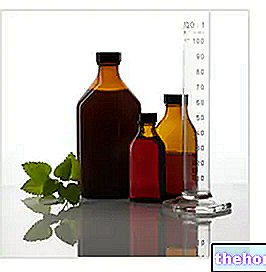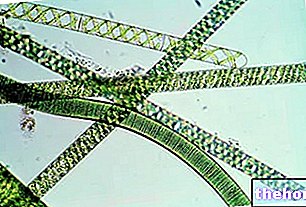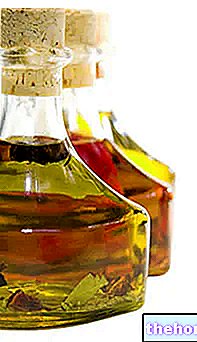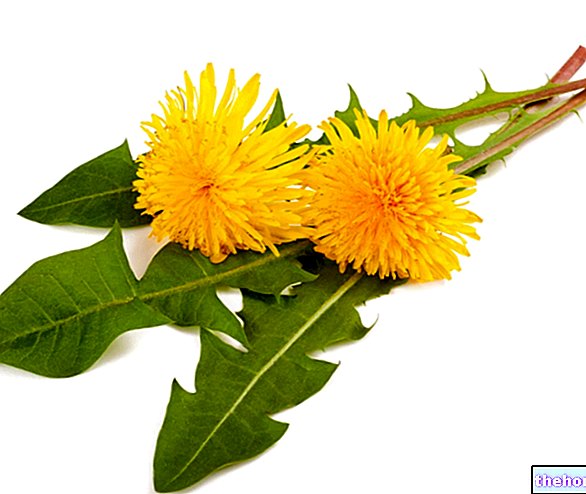Green algae: introduction
Scientifically known as Chloroficee or Chlorophyta, green algae represent a heterogeneous group of unicellular and multicellular organisms, with more or less extensive dimensions. The Chlorophylls are green to the eye, thanks to the presence of chloroplasts: the chlorophyll pigments contained therein transform the light energy into chemical energy (photosynthetic organisms). The typical color of green algae can take on different shades based on the variety of algae and, above all, based on the composition of pigments: often, in fact, chlorophyll is mixed with other red pigments (hematochromes), or yellow (xanthophylls).

In addition to these colored substances, green algae may contain colorless pigments, known as pyrenoids.
Biological hypotheses
In light of some recent scientific assumptions, it seems that higher plants evolved from green algae. To confirm this hypothesis, it was first observed that green algae have a nuclear envelope that dissolves during mitosis; also the presence of chlorophyll (type a and b) and the accumulation of starch inside the plastids (peculiarity of green algae and higher plants) seems to support the theory. Finally, the presence of fragmoplast (cellular structure that derives from the alignment of microtubules during the cell division phase) and of a particular photo-respiratory enzyme (glycolate oxidase) inside the peroxisomes, constitutes a further biological confirmation.
Following these observations, it is almost confirmed that green algae have originated approximately 300,000 species of terrestrial higher plants.
Botanical description
Green algae live mainly in fresh waters (90%), but some species proliferate in marine environments; moreover, green algae spread in areas with a very high humidity level, and in proximity to other plants.
We have seen that green algae are unicellular and multicellular organisms: there are about 6,500-9,000 different species, distinguished by their peculiar characteristics and by way of reproduction. Green algae are classified into around 600 different orders.
The chloroplasts are formed by 2-6 thylakoids, fused together; moreover, the organelles used for photosynthesis are devoid of endoplasmic reticulum and starch represents the reserve carbohydrate present inside the plastids.
Cellulose, when present, is located in the cell wall.
The reproduction of green algae - and algae in general - can be vegetative (asexual) or gamic (sexual): the vegetative reproduction, typical of unicellular algae, consists in the simple division of the mother cell into two daughter cells, while the asexual reproduction of multicellular algae occurs most often by fragmentation. Sexual reproduction, clearly more complex, consists in the union of two specialized cells belonging to two different individuals.
Vitamins and minerals
The green alga par excellence is certainly the so-called sea lettuce, scientifically known as Ulva lactuca: belongs to the family of Ulvaceae and it is a "typical alga of the Mediterranean waters and cold temperate seas. The leaves, not very large and thin, are attached to a helical peduncle [taken from http://it.wikipedia.org/]. In the eastern regions, sea lettuce is consumed as food, in the form of soups and salads: with a fair content of Omega-3, B vitamins, pro-vitamins A and C, these green algae are particularly rich in mineral salts (especially calcium and magnesium ) and contain all 8 essential amino acids Sea lettuce is rich in starch polysaccharides and water-soluble amylopectins, with properties similar to the starches contained in potatoes.
Among the most important green algae, they are also remembered Acetabularia (single-cell model for biological research) and the prickly pear of sea (Halimeda tuna), whose vulgar name derives from the very particular morphological aspect.
Summary
Green algae: in brief
- The chlorophyll pigments contained in the chloroplasts transform the light energy into chemical energy → green algae are photosynthetic organisms
- Different shades due to the presence of other red (hematochromes) or yellow (xanthophylls) pigments
- Possible presence of colorless pigments: pyrenoids
Confirmations:
- nuclear envelope that dissolves during mitosis
- presence of chlorophyll
- accumulation of starch inside the plastids
- presence of fragmoplast
- particular photo-respiratory enzyme (glycolate oxidase) inside the peroxisomes
- both higher plants and green algae have these characteristics
- Habitat: sea and fresh water (90%)
- 6,500-9,000 species classified in 600 orders
- Chloroplasts: they consist of 2-6 thylakoids, fused together and without endoplasmic reticulum
- Starch: reserve carbohydrate present inside the plastids
- Reproduction: can be vegetative (asexual) or gamic (sexual)
- Ulva lactuca: belongs to the family of Ulvacea
- Leaves: not very large and thin, attached to a helical peduncle
- Uses: food (soups and salads)
- Nutritional components: Omega-3, group B vitamins, vitamins A and C, mineral salts (especially calcium and magnesium), 8 essential amino acids, water-soluble amylopectins, starch polysaccharides
Select plant Fir Acacia Acerola Sorrel Yarrow Yarrow Yarrow Aconito Adatoda Garlic Agnocasto Agrimonia Alchemilla Alkekengi Aloe Altea Witch Hazel Ammi or Visnaga Pineapple Andrographis Anemone Pulsatilla Angelica Anise Star Anise Japanese Star Anise Bitter Orange Bitter Areca Arnica Harpagophytum Arpagophyte Artemisia Asteragus Basil Asparagus Asparagus Peruvian Asparagus Asparagus Asparagus Hawthorn Boldo Borage Shepherd's Purse Boswellia Bucco Butea superba Cocoa Coffee Cajeput Calamus Calamus Marigold Camedrio Chamomile Roman Chamomile Camphor Cinnamon Ceylon Maidenhair Capuchin Artichoke Cardamom Cardiac Thistle Asian Thistle Carvi Cascara Cassia Catecu Catha Cabbage Celandine Chicory Centaurea Cinnamon Cypress Celandine Chives Cypress Coca Cola Colchico Combreto Condurango Comfrey Coriander Cranberry Barberry American Chrysanthemum Cumin Turmeric Damiana Digital Dioscorea Drosera Dulcamara Dunalilella Echinacea Eder a Ephedra Elenio Eleutherococcus Helichrysum Evening primrose Horsetail Alfalfa Erica Euphrasia Erisimo Escolzia Eucalyptus Farfara Farfaraccio Calabar bean Fenugreek Fennel Phytolacca Frangola Ash Fumaria Japanese Mushrooms Galega Ganoderma lucidum Garcinia Cambogia Mulberry Gentian Broom Ginkgo Ginkgo Guipana Guipana Gynestra Ginkgo Hibelia Gymnasium Hibiscus Guarulp St. John's Wort Horse Chestnut Ispaghul Hyssop Jaborandi Kava kava Konjac Laminaria Cherry Laurel Lavender Lemongrass Lespedeza Lovage Icelandic Lichen Lemon Flax Lippia Licorice Lobelia Hops Maca Marjoram Maize Mallow Manna Marrubio Marrubio d "water Matè Melaleuca Meliloto American Lemon balm Myrtle Myrama Walnut Nutmeg Walnut vomica Olive tree Meadowsweet Ononide Opuntia Oregano Orthosiphon Nettle Poppy Papaya Parietaria Feverfew Passiflora Chilli Perilla Periwinkle Phyllanthus Plantain Picrorhiza Pilosella Pino Pisci dia Podofillo Polygala Grapefruit Parsley Psyllium Pueraria mirifica Butcher's broom Pygeum Quassia Oak Rhubarb Ratania Rauwolfia currant Castor bean Rhodiola Rosehip Rosemary Rue Willow Sarsaparilla Sage Elderberry Sassafras Sedum Ergot Senna Serenoa Repens Soybean Solidago Tansy Taraxus Tamarind Tamarind Tamarind Tamarind Tamarindo Ursina Valerian Vanilla Mullein Verbena Veronica Viburnum Vinca Pansy Mistletoe Vine Withania Yohimbe Saffron Ginger Pumpkin Select disease Juvenile Acne Rosacea Tinnitus Tinnitus Aerophagia Tendon Affections Afonia Aphthae Algias Functional Halitosis Breastfeeding Allergy Anemia Anguish Anxiety Arteriosclerosis Asthrosis Asthrosis Arthritis Arthritis Men Sex Woman Blepharitis and Conjunctivitis Eye bags Bronchitis Gallstones Kidney stones Salivary stones Baldness Androgenetic Candida Fragile hair Caries Headache Cellulitis Motion sickness Cystitis C limaterio Cholecystopathy High cholesterol Ulcerative colitis Colonoscopy Contusions Hematoma Convalescence Couperose Depression Dermatitis Diaper dermatitis Diabetes Diarrhea Erectile dysfunction Dyslipidemia Dysmenorrhea Dyspepsia Disturbances of vision Hemorrhoids Epistaxis Herethism Heart disease Fever Fibromyalgia Gastro-intestinal disease Flatulence Hypertension Fibromyalgia Gastrointomnia Jaundice Laryngitis Renal lithiasis Toothache Sore throat Thinness Menopause Meteorism Mononucleosis Alzheimer's disease Crohn's disease Nausea Vomiting Obesity Dark circles Onychomycosis Osteoporosis Dry skin Periarthritis Piorea Low pressure Prostatitis Psoriasis Colds Breast fissures Anal fissures Gastro-nasal rhinitis Senescence Premenstrual Syndrome Sinusitis Quit smoking Overweight Fatty liver Constipation Stomatitis Stress Cough Triglycerides high Ulcer Burns Nails Brittle flashes Heat Warts Dizziness Properties herbal Tanning Abortive adaptogenic Aphrodisiac bittering analgesic anesthetic anorectics analgesic antacid anti-allergic anti-asthmatic Antibiotic catarrh Anticellulitiche anticonvulsant Antidiaforetiche antidiarrheal edematous anthelmintic antiemetic Antiemorroidarie antiphlogistic Antiidrotiche Antinevrotiche Antioxidants antipyretic antirheumatic antiscorbutic Antiseptic antispasmodic anti-uric Aperitive Flavoring Astringent Balsamic Bechiche Capillarotrope Cardiotonic Carminative Cathartic Caustics Healing Cholagogues Choleretic Dyes Decongestants Deodorants Purifying Diaphoretic Cleansers Disinfectants Detoxifiers Thirst quenching Diuretics Exciting Emetics Emmenagogues Emollients Hemostatic Energies Hepatoprotectors Expectorants Eupepticus Moisturisers Galactosensitizers lanti Hypertensive Hypnotic Hypoglycemic Hypotensive Irritants Laxatives Soothing Narcotic Nerves Nutrients Odontalgic Pectoral Purgative Revulsive Remineralizing Refreshing Rubefacient Scialagoghe Sedative Soporifugas Sneezing Stomachic Stomatics Narcotic Vascular Tightenitis




























